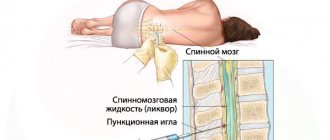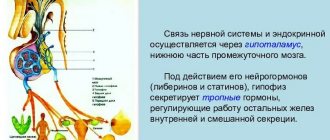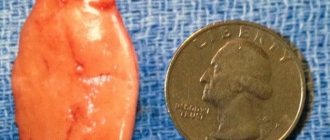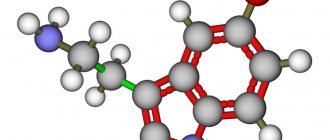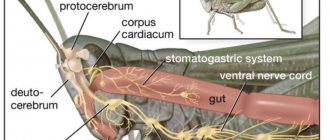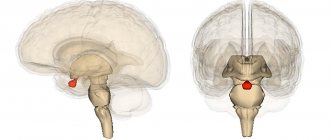The pituitary gland is the “commander in chief” of our body. This small gland is responsible for the production of hormones, which in turn regulate the functioning of other glands and the production of dozens of other hormones. If the pituitary gland begins to produce substances in excess or insufficient quantities, this leads to the development of various diseases.
The SANMEDEXPERT clinic successfully diagnoses and treats pituitary dysfunction, which helps to effectively treat patients and prevent dozens of diseases.
Causes of dysfunction
Pituitary adenoma is a benign tumor, the main reason why the gland begins to produce large amounts of the hormone.
A decrease in secretion can be caused by a greater number of factors:
- irradiation;
- cerebral hemorrhages;
- traumatic brain injuries;
- surgical intervention;
- congenital pathologies of the pituitary gland;
- brain tumors compressing the gland;
- any form of cerebrovascular accident;
- inflammatory diseases (encephalitis, meningitis).
Antidiuretic hormone (vasopressin)
The main function of antidiuretic hormone, also known as vasopressin, is to maintain fluid balance. It increases the volume of fluid in the body by stimulating the absorption of water in the kidney channels. This hormone is released by the hypothalamus when it detects a lack of water in the blood.
Once the hormone is released, the kidneys respond by absorbing more water and producing more concentrated urine (less dilute urine). Thus, it helps stabilize the water level in the blood. The hormone is also responsible for increasing blood pressure by constricting arterioles, which is extremely important during shock blood loss as an adaptation mechanism.
The active growth of vasopressin is promoted by low blood pressure, dehydration and large blood loss. The hormone can remove sodium from the blood, saturate body tissues with fluid and, in combination with oxytocin, improve brain activity.
Low levels of vasopressin in the blood contribute to the development of diabetes insipidus, a disease characterized by polyuria (6-15 liters of urine per day) and polydipsia (thirst). Excessive production of this hormone is quite rare. It leads to Parhon's syndrome, which causes low blood density and high sodium levels. In addition, such patients will be plagued by a number of “unpleasant” symptoms: rapid weight gain, headache, nausea, loss of appetite, general weakness.
Symptoms of pituitary gland disorders
Signs of operational problems should also be divided into two groups.
So, you can suspect a lack of hormones produced by the pituitary gland if you have the following symptoms:
- Hypothyroidism develops as a result of decreased efficiency of the thyroid gland. It manifests itself in the form of constant fatigue, weakness in the limbs, muscle and headaches, brittle nails and dry skin, and a constantly depressed mood.
- Dwarfism is dangerous because the first signs of the disease appear only at 2-3 years of age. The baby's growth and physical development slow down. But if treatment is started immediately, the disease can be overcome and the child’s growth will normalize.
- Disruption of the anterior pituitary gland leads to the development of hypopituitarism. Its symptoms depend on which hormone is missing in the body. As a rule, the disease is the cause of infertility. Women do not have menstruation; men are diagnosed with impotence, testicular atrophy, and a decrease in sperm count.
- With diabetes insipidus, which develops due to a lack of vasopressin, the patient experiences a constant feeling of thirst and a frequent urge to urinate. The disease is also signaled by an increase in the volume of urine excreted (up to 20 liters).
Diseases caused by an excess of hormones manifest themselves as follows:
- Hyperprolactinemia is a common cause of male and female infertility. The main symptom of the disease, both in men and women, is milk secreted by the mammary glands.
- An excess of growth hormone leads to the development of gigantism. The main symptom is a small head with great height (2 meters) and long limbs. Many patients with this diagnosis do not live to old age, since the disease is accompanied by a large number of complications.
- The difference between acromegaly is that growth hormone begins to be produced in excess after the development of the body has completed. In this case, the bones, feet, and facial part of the skull increase.
- A serious disease is Itsenko-Cushing's disease. Obesity, decreased immunity, high blood pressure, sexual dysfunction are the main symptoms.
Let's talk separately about the symptoms of pituitary adenoma. It is necessary to undergo examination in the following cases:
- A sharp decrease in vision.
- Headaches do not stop even after taking special medications.
- The appearance of signs of one of the diseases described above.
Anterior pituitary insufficiency - symptoms
Symptoms caused by deficiency of pituitary tropic hormones:
1. Growth hormone (GH) deficiency:
- In children, growth retardation, the so-called pituitary dwarfism, means that the body proportions and intelligence are correct.
- In adults, loss of muscle mass and body fat; decrease in bone density, formation of fine wrinkles on the face. The concentration of LDL cholesterol is increased, which contributes to the earlier development of atherosclerosis and cardiac problems in these patients.
2. Gonadotropin deficiency (LH, FSH) - symptoms of hypogonadism, that is, decreased testicular and ovarian function: amenorrhea, decreased libido, decreased potency, pubic hair loss.
3. Prolactin deficiency - lack of lactation after childbirth.
4. Deficiency of thyrotropin (TSH) - symptoms of hypothyroidism: easy fatigue, apathy, cold intolerance, weight gain, dry skin, hair loss, constipation.
Diagnosis and treatment
If you suspect a dysfunction of the pituitary gland, you should contact experienced endocrinologists at our clinic.
Diagnostics is carried out in several stages:
- A conversation with the patient, the subject of which is complaints, chronic diseases, and the presence of a genetic predisposition.
- Clinical studies, in particular blood tests to determine hormone levels.
- Ultrasound of the brain and/or tomography is a mandatory part of the examination.
Treatment of pituitary dysfunction is a long process. In most cases it is lifelong. The fight against diseases is carried out by prescribing replacement therapy, which makes up for the lack of hormones, or taking medications to suppress the increased activity of the gland. Surgery and radiation therapy are prescribed if a tumor is present.
Preparing for MRI of the pituitary gland of the brain
If you plan to use contrast, it is recommended to limit food intake 3-4 hours before the procedure. No other special preparation is required.
Before starting the procedure, you must inform the doctor about the presence of any implants or foreign bodies in the body, provide your medical history and the results of all previously conducted studies, remove all metal accessories and lay out bank and other magnetic cards.
If contrast was used, the patient is observed for at least 30 minutes after its administration, after which you can return to the normal rhythm of life.
Structure
The pituitary gland is part of the hypothalamic-pituitary system of the brain. This association is a decisive component in the activity of the human nervous and endocrine system. In addition to anatomical proximity, the pituitary gland and hypothalamus are tightly connected functionally. In hormonal regulation, there is a hierarchy of glands, where the main regulator of endocrine activity, the hypothalamus, is located at the vertical height. It produces two types of hormones – liberins and statins (releasing factors). The first group increases the synthesis of pituitary hormones, and the second group inhibits it. Thus, the hypothalamus completely controls the functioning of the pituitary gland. The latter, receiving a dose of liberins or statins, synthesizes substances necessary for the body or, on the contrary, stops their production.
The pituitary gland is located on one of the structures of the base of the skull, namely the sella turcica. This is a small bony pocket located on the body of the sphenoid bone. In the center of this pocket is the pituitary fossa, protected behind by the dorsum and in front by the tubercle of the sella. At the bottom of the dorsum of the sella there are grooves containing the internal carotid arteries, a branch of which, the inferior pituitary artery, supplies the inferior cerebral appendage with substances.
Adenohypophysis
The pituitary gland consists of three small parts: the adenohypophysis (anterior part), the intermediate lobe and the neurohypophysis (posterior part). The middle lobe is similar in origin to the anterior lobe and appears as a thin septum separating the two lobes of the pituitary gland. However, the specific endocrine activity of the layer forced specialists to identify it as a separate part of the lower cerebral appendage.
The adenohypophysis consists of separate types of endocrine cells, each of which secretes its own hormone. In endocrinology, there is the concept of target organs - a set of organs that are targets for the directed activity of individual hormones. So, the anterior lobe produces tropic hormones, that is, those that affect the glands lower in the hierarchy of the vertical system of endocrine activity. The secretion secreted by the adenohypophysis initiates the work of a specific gland. Also, according to the principle of feedback, the anterior part of the pituitary gland, receiving an increased amount of hormones from a certain gland in the blood, suspends its activity.
Neurohypophysis
This section of the pituitary gland is located in its posterior part. Unlike the anterior part, the adenohypophysis, the neurohypophysis not only performs a secretory function, but also acts as a “container”: hypothalamic hormones descend along nerve fibers to the neurohypophysis and are stored there. The posterior lobe of the pituitary gland consists of neuroglia and neurosecretory bodies. Hormones stored in the neurohypophysis influence water metabolism (water-salt balance) and partially regulate the tone of small arteries. In addition, the secretion of the posterior part of the pituitary gland actively takes part in the birth processes of women.
Intermediate share
This structure is represented by a thin ribbon with protrusions. Behind and in front, the middle section of the pituitary gland is limited by thin balls of the connective layer containing small capillaries. The structure of the intermediate lobe itself consists of colloid follicles. The secretion of the middle part of the pituitary gland determines the color of a person, but is not decisive in the difference in skin color of different races.
Diagnostic measures
Any disturbances in the functioning of the pituitary gland, as described above, are diagnosed using magnetic resonance imaging or a comprehensive blood test. But most pathologies can be detected during a visual examination of the patient. For example, with insufficient secretion of growth hormones, a person will have pale skin and a large amount of dandruff on the head. This is explained by the fact that with insufficient protein secretion, the skin also suffers, in which micronutrients are not transformed.
Mentioning the place where the pituitary gland is located, one can guess that it is also connected with the work of the hypothalamus, and that, in turn, with the manifestation of feelings. For example, sharply deteriorating vision may indicate a deficiency or excess of hormonal levels in an adult. In the USA, by the way, a rapid test is used to determine pathologies in the pituitary gland; special reagents and the patient’s blood are used for this. However, they provide inaccurate information, the probability of error is about 12%, which is considered a significant deviation from the norm.

